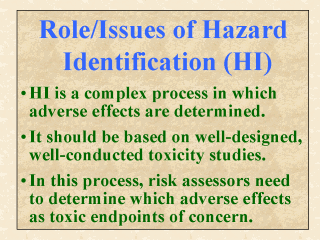| front |1 |2 |3 |4 |5 |6 |7 |8 |9 |10 |11 |12 |13 |14 |15 |16 |17 |18 |19 |20 |21 |22 |23 |24 |25 |26 |27 |review |
 |
Hazard
identification (HI) is the step in which adverse effects are determined. This process does
not have to initiate with the use of controlled animal (or human) toxicity studies.
However, for health risk assessment (RA) purposes, especially in a regulatory setting, the
use of well-conducted (animal) toxicity studies is almost inevitable. This is because strong
evidence is required to ensure that the adverse effect is indeed caused by the suspect
agent or activity. Human data are almost unattainable, in that it is unethical to
deliberately subject humans to a dose high enough to cause them some bodily harm. HI is by no means a simple process although it may be considered easier to accomplish compared to human exposure assessment. Many agents are capable of inducing more than one type of effects, depending on the route, the amount, and the duration of dosing, and on the species tested. Where two or more types of effects were observed, they might (not) have been caused by exposure(s) via the same route or at the same level. The risk assessor needs to determine which adverse effects should be the toxic endpoint(s) of concern, by following the strength- and weight-of-evidence principles. The endpoint with the lowest NOEL (no observed effect level) may not always be the best candidate, as such is more health protective and credible only if it is derived from sufficient convincing evidence. Another problem has to do with risk perception. For example, skin sensitization is often treated as a secondary adverse effect even when compared to decreased body weight. This is not because the former is less detrimental, but because it is less tangible. |